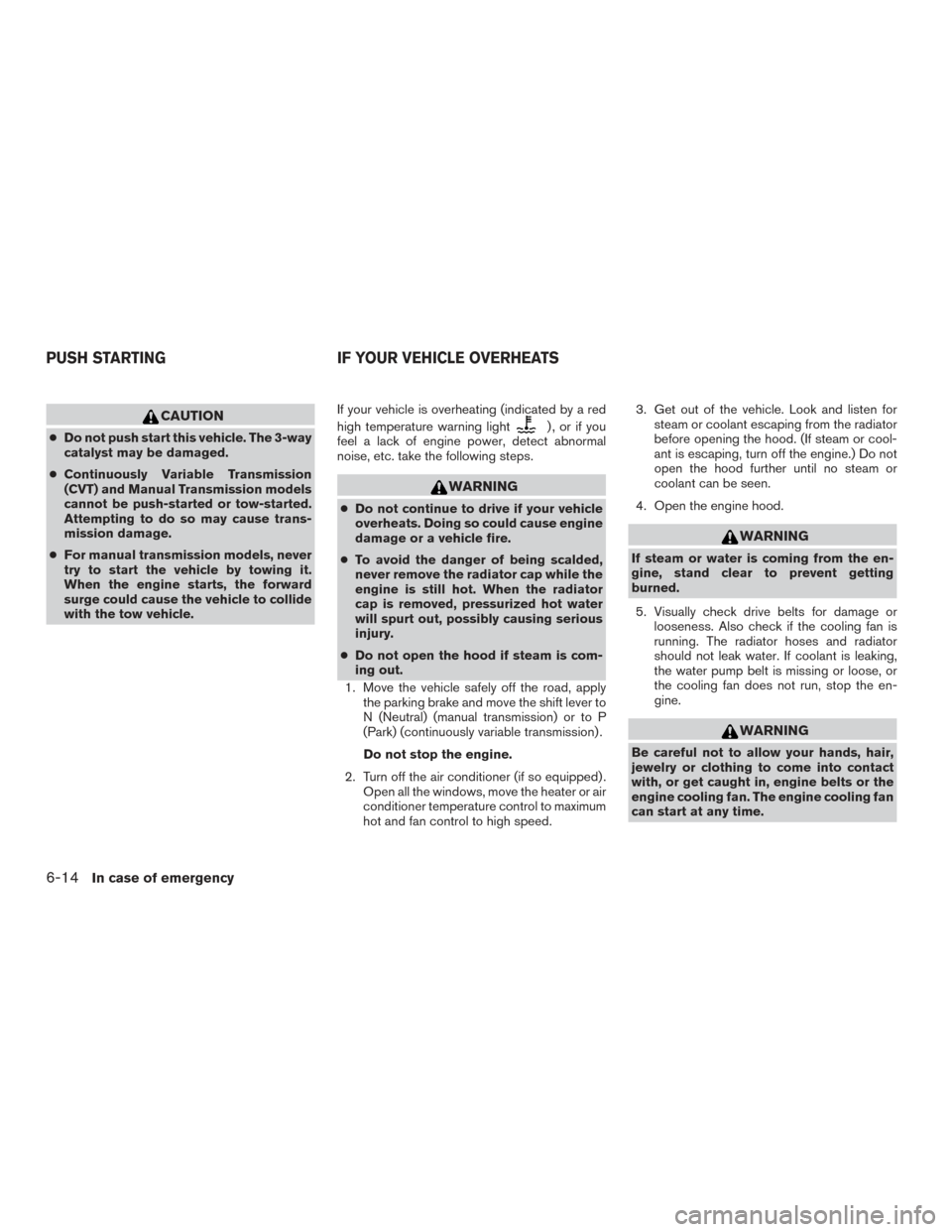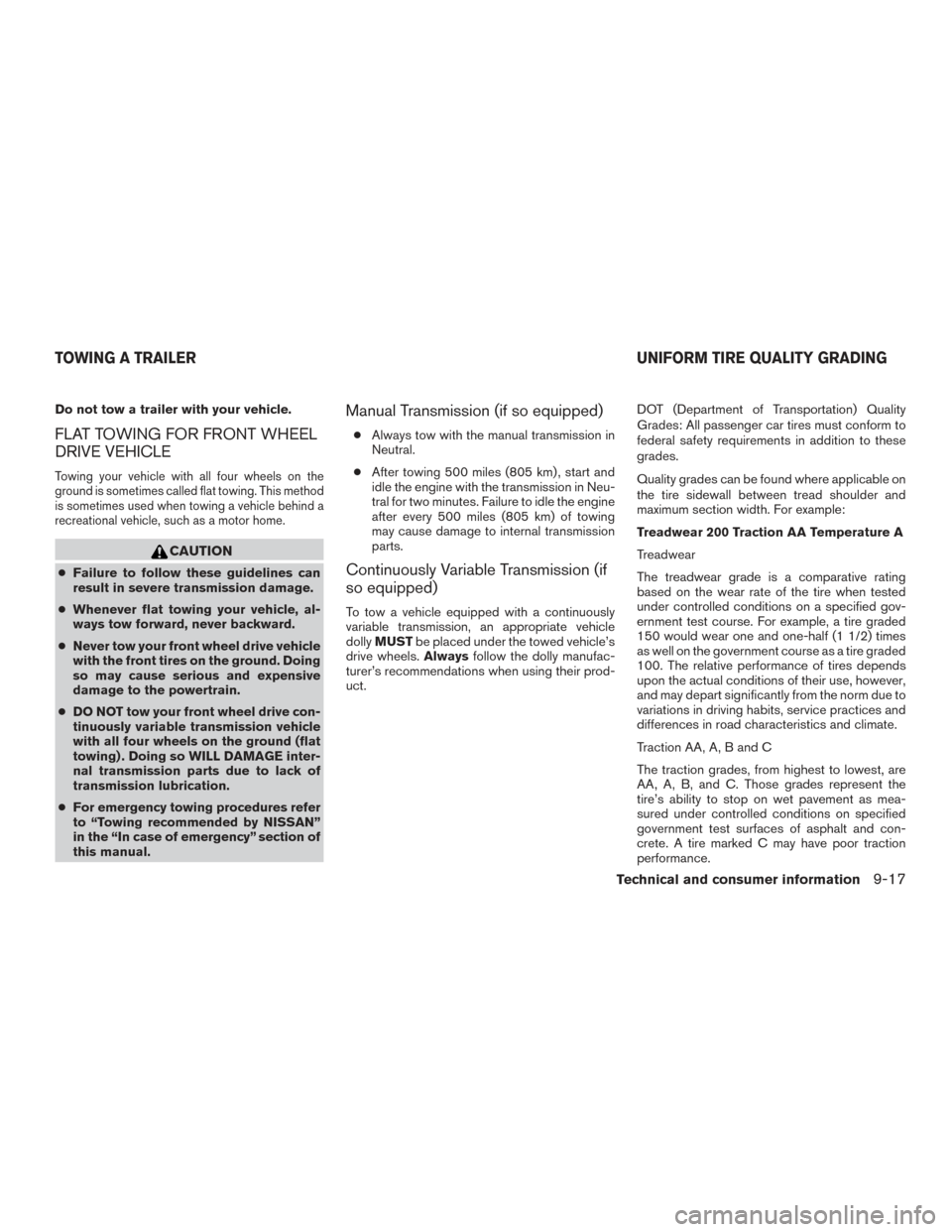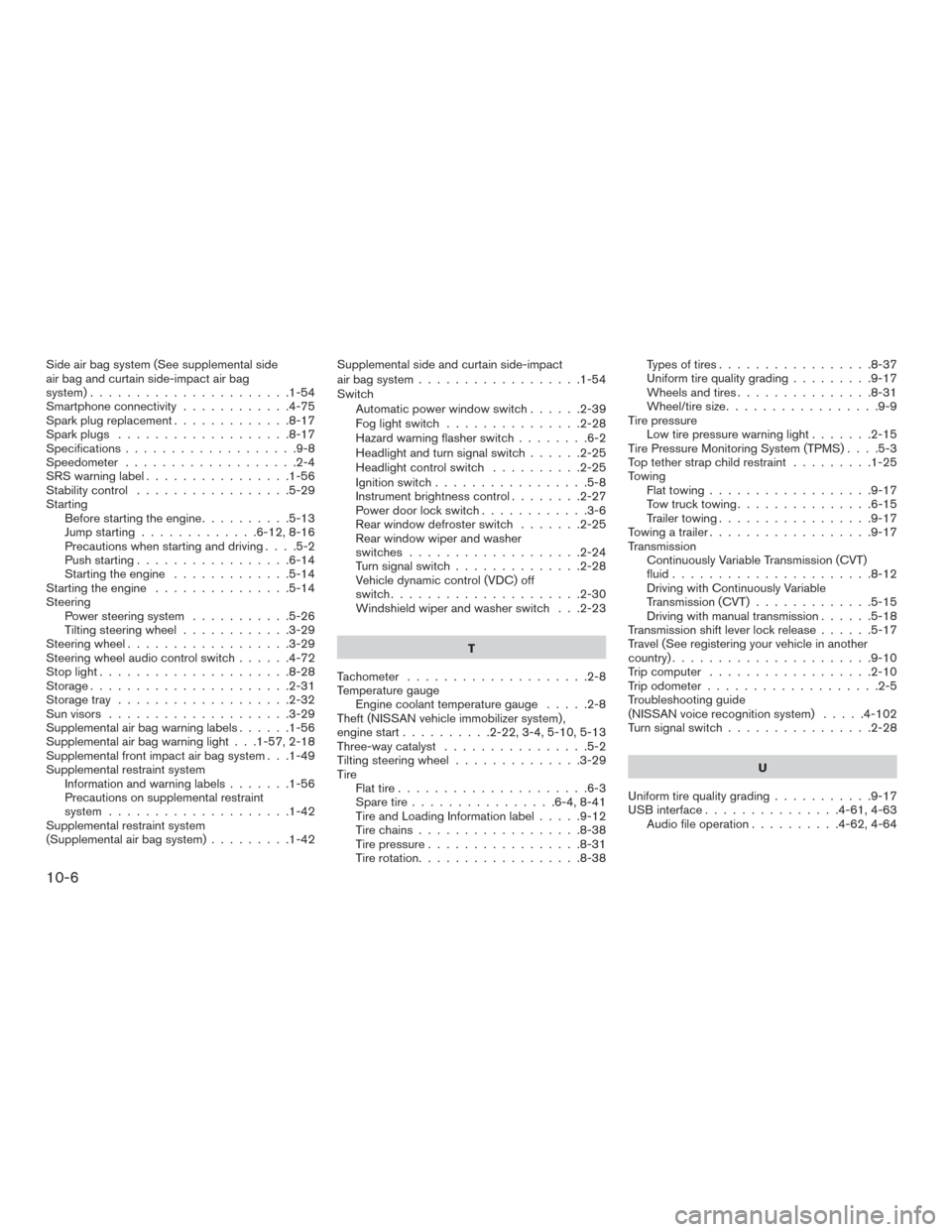2015 NISSAN VERSA NOTE stop start
[x] Cancel search: stop startPage 301 of 384

CAUTION
●Do not push start this vehicle. The 3-way
catalyst may be damaged.
● Continuously Variable Transmission
(CVT) and Manual Transmission models
cannot be push-started or tow-started.
Attempting to do so may cause trans-
mission damage.
● For manual transmission models, never
try to start the vehicle by towing it.
When the engine starts, the forward
surge could cause the vehicle to collide
with the tow vehicle. If your vehicle is overheating (indicated by a red
high temperature warning light) , or if you
feel a lack of engine power, detect abnormal
noise, etc. take the following steps.
WARNING
● Do not continue to drive if your vehicle
overheats. Doing so could cause engine
damage or a vehicle fire.
● To avoid the danger of being scalded,
never remove the radiator cap while the
engine is still hot. When the radiator
cap is removed, pressurized hot water
will spurt out, possibly causing serious
injury.
● Do not open the hood if steam is com-
ing out.
1. Move the vehicle safely off the road, apply the parking brake and move the shift lever to
N (Neutral) (manual transmission) or to P
(Park) (continuously variable transmission) .
Do not stop the engine.
2. Turn off the air conditioner (if so equipped) . Open all the windows, move the heater or air
conditioner temperature control to maximum
hot and fan control to high speed. 3. Get out of the vehicle. Look and listen for
steam or coolant escaping from the radiator
before opening the hood. (If steam or cool-
ant is escaping, turn off the engine.) Do not
open the hood further until no steam or
coolant can be seen.
4. Open the engine hood.
WARNING
If steam or water is coming from the en-
gine, stand clear to prevent getting
burned.
5. Visually check drive belts for damage or looseness. Also check if the cooling fan is
running. The radiator hoses and radiator
should not leak water. If coolant is leaking,
the water pump belt is missing or loose, or
the cooling fan does not run, stop the en-
gine.
WARNING
Be careful not to allow your hands, hair,
jewelry or clothing to come into contact
with, or get caught in, engine belts or the
engine cooling fan. The engine cooling fan
can start at any time.
PUSH STARTING IF YOUR VEHICLE OVERHEATS
6-14In case of emergency
Page 370 of 384

Do not tow a trailer with your vehicle.
FLAT TOWING FOR FRONT WHEEL
DRIVE VEHICLE
Towing your vehicle with all four wheels on the
ground is sometimes called flat towing. This method
is sometimes used when towing a vehicle behind a
recreational vehicle, such as a motor home.
CAUTION
●Failure to follow these guidelines can
result in severe transmission damage.
● Whenever flat towing your vehicle, al-
ways tow forward, never backward.
● Never tow your front wheel drive vehicle
with the front tires on the ground. Doing
so may cause serious and expensive
damage to the powertrain.
● DO NOT tow your front wheel drive con-
tinuously variable transmission vehicle
with all four wheels on the ground (flat
towing) . Doing so WILL DAMAGE inter-
nal transmission parts due to lack of
transmission lubrication.
● For emergency towing procedures refer
to “Towing recommended by NISSAN”
in the “In case of emergency” section of
this manual.
Manual Transmission (if so equipped)
● Always tow with the manual transmission in
Neutral.
● After towing 500 miles (805 km) , start and
idle the engine with the transmission in Neu-
tral for two minutes. Failure to idle the engine
after every 500 miles (805 km) of towing
may cause damage to internal transmission
parts.
Continuously Variable Transmission (if
so equipped)
To tow a vehicle equipped with a continuously
variable transmission, an appropriate vehicle
dolly MUST be placed under the towed vehicle’s
drive wheels. Alwaysfollow the dolly manufac-
turer’s recommendations when using their prod-
uct. DOT (Department of Transportation) Quality
Grades: All passenger car tires must conform to
federal safety requirements in addition to these
grades.
Quality grades can be found where applicable on
the tire sidewall between tread shoulder and
maximum section width. For example:
Treadwear 200 Traction AA Temperature A
Treadwear
The treadwear grade is a comparative rating
based on the wear rate of the tire when tested
under controlled conditions on a specified gov-
ernment test course. For example, a tire graded
150 would wear one and one-half (1 1/2) times
as well on the government course as a tire graded
100. The relative performance of tires depends
upon the actual conditions of their use, however,
and may depart significantly from the norm due to
variations in driving habits, service practices and
differences in road characteristics and climate.
Traction AA, A, B and C
The traction grades, from highest to lowest, are
AA, A, B, and C. Those grades represent the
tire’s ability to stop on wet pavement as mea-
sured under controlled conditions on specified
government test surfaces of asphalt and con-
crete. A tire marked C may have poor traction
performance.
TOWING A TRAILER
UNIFORM TIRE QUALITY GRADING
Technical and consumer information9-17
Page 376 of 384

10 Index
A
ABS (Anti-lock Braking System) ........5-28
Air bag (See supplemental restraint
system) .....................1-42
Air bag system Front (See supplemental front impact
air bag system) ...............1-49
Side and curtain (See supplemental
side air bag and curtain side-impact
air bag system) ...............1-54
Airbagwarninglabels.............1-56
Airbagwarninglight...........1-57,2-18
Air bag warning light, supplemental . .1-57, 2-18
Air cleaner housing filter ............8-18
Air conditioner Air conditioner operation ..........4-26
Air conditioner service ...........4-31
Air conditioner specification label .....9-12
Air conditioner system refrigerant and
oil recommendations .............9-7
Air conditioner system refrigerant
recommendations ..............9-7
Heater and air conditioner controls ....4-23
Servicing air conditioner ..........4-31
Airflowcharts..................4-27
Anchor point locations .............1-25
Antenna .....................4-74
Anti-lock brake warning light ..........2-14
Anti-lock Braking System (ABS) ........5-28
Apps .......................4-75
Armrests .....................1-5 Around View™ Monitor
.............4-14
Audible reminders ...............2-21
Audio system ..................4-31
AMradioreception.............4-32
Bluetooth®audio..........4-70,4-71
Bluetooth® streaming audio ........4-71
Compact disc (CD)
player..........4-42,4-47,4-52,4-59
FM/AM radio with compact disc (CD)
player ....................4-44
FM-AM radio with compact disc (CD)
player ....................4-40
FM/AM/SAT radio with compact disc (CD)
player.................4-49,4-54
FMradioreception..........4-31,4-45
iPod® Player .............4-65,4-67
iPod® player operation .......4-65,4-67
Radio ....................4-31
Steering wheel audio control switch . . .4-72
USB interface ............4-61,4-63
USB (Universal Serial Bus) Connection
Port..................4-61,4-63
Automatic Automatic power window switch .....2-39
Automatic transmission position indicator
light .....................2-19
Automatic door locks ..............3-7
AUXjack..............4-43,4-45,4-61
B
Battery ..................5-32,8-14 Charge warning light
............2-15
Battery replacement Keyfob ...................8-24
NISSAN Intelligent Key® ..........8-25
Before starting the engine ...........5-13
Belt (See drive belt) ..............8-17
Block heater Engine ....................5-33
Bluetooth® audio ............4-70,4-71
Bluetooth® hands-free phone
system..................4-76,4-91
Boosterseats..................1-39
Brake Anti-lock Braking System (ABS) ......5-28
Brake fluid ..................8-13
Brakelight(Seestoplight).........8-28
Brake system ................5-27
Brakewarninglight.............2-14
Brakewearindicators........2-21,8-20
Parking brake operation ..........5-20
Self-adjusting brakes ............8-20
Brake fluid ....................8-13
Brakes ......................8-20
Brake system ..................5-27
Break-inschedule ...............5-23
Brightness/contrast button ...........4-9
Brightness control Instrument panel ..............2-27
Bulb check/instrument panel ..........2-14
Bulbreplacement................8-28
Page 381 of 384

Side air bag system (See supplemental side
air bag and curtain side-impact air bag
system)......................1-54
Smartphone connectivity............4-75
Spark plug replacement .............8-17
Spark plugs ...................8-17
Specifications ...................9-8
Speedometer ...................2-4
SRS warning label ................1-56
Stability control .................5-29
Starting Before starting the engine ..........5-13
Jump starting .............6-12,8-16
Precautions when starting and driving ....5-2
Push starting .................6-14
Starting the engine .............5-14
Starting the engine ...............5-14
Steering Power steering system ...........5-26
Tilting steering wheel ............3-29
Steering wheel ..................3-29
Steering wheel audio control switch ......4-72
Stoplight.....................8-28
Storage......................2-31
Storage tray ...................2-32
Sun visors ....................3-29
Supplemental air bag warning labels ......1-56
Supplemental air bag warning light . . .1-57, 2-18
Supplemental front impact air bag system . . .1-49
Supplemental restraint system Information and warning labels .......1-56
Precautions on supplemental restraint
system ....................1-42
Supplemental restraint system
(Supplemental air bag system) .........1-42Supplemental side and curtain side-impact
air bag system
..................1-54
Switch Automatic power window switch ......2-39
Foglightswitch ...............2-28
Hazard warning flasher switch ........6-2
Headlight and turn signal switch ......2-25
Headlight control switch ..........2-25
Ignition switch .................5-8
Instrument brightness control ........2-27
Power door lock switch ............3-6
Rear window defroster switch .......2-25
Rear window wiper and washer
switches...................2-24
Turn signal switch ..............2-28
Vehicle dynamic control (VDC) off
switch.....................2-30
Windshield wiper and washer switch . . .2-23
T
Tachometer ....................2-8
Temperature gauge Engine coolant temperature gauge .....2-8
Theft (NISSAN vehicle immobilizer system) ,
engine start ..........2-22,3-4,5-10,5-13
Three-way catalyst ................5-2
Tilting steering wheel ..............3-29
Tire Flat tire .....................6-3
Spare tire ................6-4,8-41
Tire and Loading Information label .....9-12
Tirechains..................8-38
Tire pressure .................8-31
Tirerotation..................8-38 Types of tires
.................8-37
Uniform tire quality grading .........9-17
Wheels and tires ...............8-31
Wheel/tire size .................9-9
Tire
pressure
Low tire pressure warning light .......2-15
Tire Pressure Monitoring System (TPMS) ....5-3
Top tether strap child restraint .........1-25
Towing Flattowing..................9-17
Towtrucktowing...............6-15
Trailer towing .................9-17
Towing a trailer ..................9-17
Transmission Continuously Variable Transmission (CVT)
fluid......................8-12
Driving with Continuously Variable
Transmission (CVT) .............5-15
Driving with manual transmission ......5-18
Transmission shift lever lock release ......5-17
Travel (See registering your vehicle in another
country) ......................9-10
Trip computer ..................2-10
Trip odometer ...................2-5
Troubleshooting guide
(NISSAN voice recognition system) .....4-102
Turn signal switch ................2-28
U
Uniform tire quality grading ...........9-17
USB interface ...............4-61,4-63
Audio file operation ..........4-62,4-64
10-6